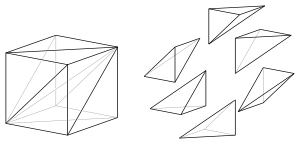- Schläfli orthoscheme
-
In geometry, Schläfli orthoscheme is a type of simplex. They are defined by a sequence of edges
 that are mutually orthogonal. These were introduced by Ludwig Schläfli, who called them orthoschemes and studied their volume in the Euclidean, Lobachevsky and the spherical geometry. H.S.M. Coxeter later named them after Schläfli. J.-P. Sydler and Børge Jessen studied them extensively in connection with Hilbert's third problem.
that are mutually orthogonal. These were introduced by Ludwig Schläfli, who called them orthoschemes and studied their volume in the Euclidean, Lobachevsky and the spherical geometry. H.S.M. Coxeter later named them after Schläfli. J.-P. Sydler and Børge Jessen studied them extensively in connection with Hilbert's third problem.Orthoschemes, also called path-simplices in the applied mathematics literature, are a special case of a more general class of simplices studied by Fiedler (1957), and later rediscovered by Coxeter (1991). These simplices are the convex hulls of trees in which all edges are mutually perpendicular. In the orthoscheme, the underlying tree is a path. In three dimensions, an orthoscheme is also called a birectangular tetrahedron.
Properties
- All 2-faces are right triangles.
- All facets of a d-dimensional orthoscheme are (d − 1)-dimensional orthoschemes.
- The midpoint of the longest edge is the center of the circumscribed sphere.
- The case when
 is a generalized Hill tetrahedron.
is a generalized Hill tetrahedron. - In 3- and 4-dimensional Euclidean space, every convex polytope is scissor congruent to an orthoscheme.
- (H.S.M. Coxeter) Every orthoscheme in a three-dimensional space of constant curvature can be dissected into three orthoschemes.
- (H.E. Debrunner) Every orthoscheme in a d-dimensional space of constant curvature can be dissected into d + 1 orthoschemes.
- Every hypercube in d-dimensional space can be dissected into d! congruent orthoschemes.
- Every d-dimensional box can be dissected into d! (not necessarily congruent) orthoschemes.
- In 3-dimensional hyperbolic and spherical spaces, the volume of orthoschemes can be expressed in terms of the Lobachevsky function, or in terms of dilogarithms, see e.g. Vinberg (1993).
See also
- Goursat tetrahedron
References
- Coxeter, H. S. M. (1971), "Frieze patterns", Acta Arithmetica 18: 297–310, http://matwbn.icm.edu.pl/ksiazki/aa/aa18/aa18132.pdf.
- Coxeter, H. S. M. (1991), "Orthogonal trees", Proc. 7th ACM Symp. Computational Geometry, pp. 89–97.
- Debrunner, Hans E. (1990), "Dissecting orthoschemes into orthoschemes", Geom. Dedicata 33 (2): 123–152.
- Fiedler, M. (1957), "Über qualitative Winkeleigenschaften der Simplexe", Czechoslovak Math. J. 7: 463–478, http://dml.cz/handle/10338.dmlcz/100260.
- Sah, C. H. (1979), Hilbert's third problem: scissors congruence, Boston: Pitman.
- Vinberg, E. B. (1993), "Volumes of non-Euclidean polyhedra", Russian Math. Surveys 48:2: 15–45.
Categories:- Polytopes
Wikimedia Foundation. 2010.

